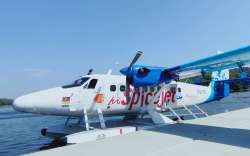India's 1st-ever seaplane services in action: 10 things to know about the flying machines
India now has onboard its first-ever seaplane services in Gujarat today. Aimed at revolutionising the country's regional connectivity, the seaplane services were between Sabarmati Riverfront in Ahmedabad and the Statue of Unity in Kevadia by Prime Minister Narendra Modi.

India now has onboard its first-ever seaplane services in Gujarat today. Aimed at revolutionising the country's regional connectivity, the seaplane services were between Sabarmati Riverfront in Ahmedabad and the Statue of Unity in Kevadia by Prime Minister Narendra Modi. The flight was operated by SpiceJet's fully-owned subsidiary, Spice Shuttle. The service is expected to boost travel and tourism, and provide last-mile connectivity. Seaplanes are the perfect flying machines that can effectively connect the remotest parts of India to the mainstream aviation network without the high costs of building airports and runways, SpiceJet Chairman and Managing Director Ajay Singh said.
10 things to know
- SpiceJet will operate two daily flights on the Ahmedabad-Kevadia route effective October 31.
- The all-inclusive one-way fares will begin from as low as Rs. 1500 under the UDAN scheme. The tickets could be bought on spiceshuttle.com.
- The seaplane service between the Sabarmati Riverfront in Ahmedabad and Statue of Unity in Kevadia will cut down travel time to just about half an hour.
- SpiceJet will be using a 15-seater Twin Otter 300 aircraft for these flights. One of the most-widely used aircraft the world over, the Twin Otter 300 is also one of the most versatile and safe aircraft. It is well-known for its reliability, rugged construction, incredible short take-off and landing capabilities, payload capacity and excellent external visibility.
- The aircraft has undergone regular maintenance, overhauling and seat refurbishment and has a valid Airworthiness Review Certificate (ARC). All the required SoPs to operate these flights are in-line with operational guidance of seaplane operations.
- The Twin Otter 300 is fitted with remarkably efficient Twin Turboprop Pratt & Whitney PT6A-27 engines, known for their reliability. The aircraft has an incredible accident-free history and is one of the most sought after aircraft for an ultimate flying experience not only in Maldives, but across the world.
- Seaplanes are the perfect flying machines that can help penetrate into untapped markets and geographies/regions that have challenges owing to its topography.
- Seaplanes have the ability to land and take-off from water thus offering access to areas that do not have landing strips or runways. Reliable, tough and resilient these smaller fixed wing aircraft can land on water bodies, gravel and grass and are thus the perfect flying machines to bring the remotest parts of India into the mainstream aviation network without the high cost of building airports and runways. Seaplanes can land in water bodies like lakes, backwaters and dams thus offering easy access to numerous tourist spots as well.
- SpiceJet has secured 18 seaplane routes under the UDAN which includes – Ahmedabad-Kevadia (Sabarmati River Front to Statue of Unity, Sardar Sarovar), Agatti-Minicoy, Agatti-Kavaratti among others. The new launch marks yet another successful beginning of the last mile connectivity by SpiceJet through sea plane service under the UDAN scheme.
- Regions in the North East, Uttarakhand, Uttar Pradesh, Andhra Pradesh, Rajasthan, Maharashtra, Andaman, Lakshadweep and other coastal areas are a few destinations that are being evaluated for amphibious plane operations.